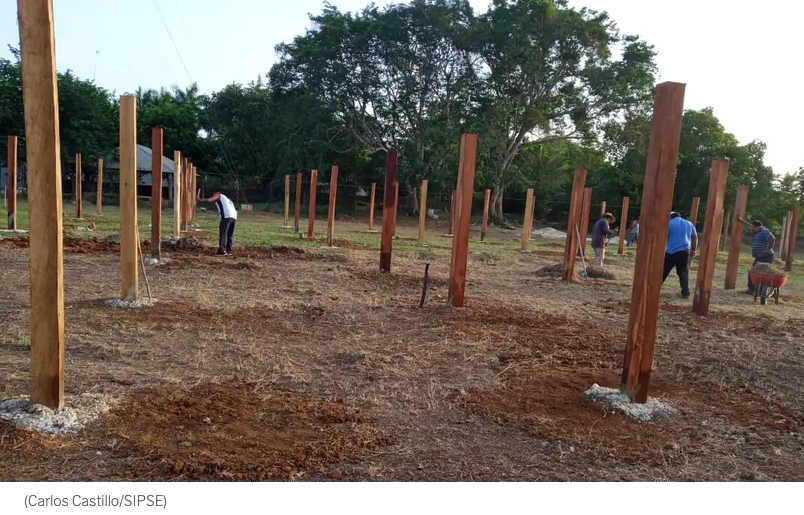Translated by Schools for Chiapas
Deforestation, loss of biodiversity, clientelism and corruption are just some of the consequences of the implementation of Sembrando Vida, the federal government’s most ambitious environmental program, which seeks to reforest a million hectares of deteriorated lands throughout Mexico.
The above is stated in numerous reports by academics, NGOs and the press. One of the studies, Analysis of the Impacts on Forest Canopies and Potential for Mitigation of Parcels of the Sembrando Vida Program in 2019, carried out by Javier Warman, Ivan Zuñiga and Manuel Cervera, indicates that the program caused the deforestation of an area of 72, 830 hectares. “There is one critical aspect related to the loss of forest canopies; the targeting of this phenomenon in only 22 municipalities of the country, and a great concentration of losses (50,981 hectares representing 70% of the losses) in those regions vulnerable to climate change and those of great biodiversity, of Chiapas, Tabasco, Yucatán, Quintana Roo and Campeche.”
For 2019, the municipality with the greatest forest loss was Ocosingo, in Chiapas, with 12,920 hectares, followed by Othón P. Blanco, in the state of Quintana Roo, with 5,829 lost hectares.
The damaged areas, 11.2% of the total area benefitted, were located by a study of satellite images and represents almost half of the annual amount of forest cover lost due to changes in land use and illegal logging in the same region, according to estimates of the World Resource Institute (WRI).
In a report published by Bloomberg, campesinos enrolled in Sembrando Vida in Yucatán and Campeche, report having logged and burned trees in order to receive money from the program.
This recent report is in addition to those circulated since the end of 2019 and during 2020. For example, in Quintana Roo, Sembrando Vida led to the deforestation of nearly 10,000 hectares of jungle, primarily in the ejidos of the southern part of the state.
“It has been noted that, in the ejidos, to have the area needed to plant fruit trees, people deforest with the approval of the federal government,” Cristóbal Uc Medina, president of the Society of Forest Ejidos of Quintana Roo, told local media.
In addition to the deforestation, the program is also implicated in the planting of non-native species in Chiapas and Tabasco, and even “some participants say that they are forced to fell the new native trees and re-plant non-native species that have died for lack of water or too much sun,” the report ¿Deforestar en vez de reforestar? Esto es lo que ocurre con Sembrando Vida. (Deforesting instead of Reforesting? This is what happens in Sembrando Vida) details.

Corruption
Sembrando Vidapays out 4,500 pesos monthly to 420 thousand farmers. It operates in 20 states and records historic budgets for the Mexican countryside with 15 billion pesos in 2019 and 27 billion in 2020.
According to the federal plan, in addition to taking care of the environment, the program seeks to combat poverty and corruption by eliminating intermediaries in the delivery of money. However, there are indications that the little to no supervision of the so-called productive and social technicians constitutes a scenario conducive to bad practices.
“There remain certain bad practices on the part of some (technicians) that abuse their power and the lack of understanding of the beneficiaries about the rules of operation of the program; at the same time there are those campesinos that seek to join Sembrando Vida without meeting the requirements, in exchange for bribes; simulation of land ownership; and more than anything, a disguised political clientelism.”
This was recorded in “Risks of Corruption in Social Programs. The Case of the Sembrando Vida Program.” elaborated by the Ethos Laboratory of Public Policy, which also points out the falsification of the properties to enter the program as well as the work in the plots..
“We have specific testimonies in Veracruz, Chiapas and Campeche of landholders that accumulate that falsify small properties, based on naming their wife, their cousin’s son, etc. as beneficiaries. We have had testimonies of people with different surnames that are the same person, because in addition, the program has the possibility of registering leased properties,” the Mexican Network of Peasant Forestry Organizations (MOCAF) details.
Among the problems identified since the beginning of the program are the deficiencies in the supply of plants, both in the construction and equipping of the community nurseries, but especially on the part of the military forestry nurseries.
In Mexico, there are 12 nurseries, distributed throughout 7 states, operated by the army, which on paper would represent the primary source of plants for Sembrando Vida. However, according to a review on the Compranet portal carried out by Ethos, due to the fact that they have not been able to achieve the necessary numbers to meet its objectives, it was authorized to award 77 suppliers direct contracts to provide 28 species and diverse varieties of plants.
The deficit in the supply of plants also enables abuses on the part of the technicians. One testimony gathered in the report of Ethos details that in the municipality of San Pedro and San Pablo Ayutla, Oaxaca, the participants of the program have neither received plants nor money to acquire the inputs for the construction of the community nursery.
For this reason, the testimony “reports that one productive technician, demanded 50,000 pesos from her mother, who is the beneficiary, and the other members of the CAC (Campesino Learning Community) made up of technicians, campesinos, and scholarship holders, in order to acquire fruit trees, who she herself would buy and bring to them so that they could start planting.”
With this deficiency, Sembrando Vida finds itself far from its goal. In 2019 alone, the first year of its implementation, despite that the objective was to plant more than 500 million trees, only 80 million were planted. By the end of 2021, and with a budget of more than 28 billion pesos, the program intends to grow more than a billion plants.
It’s worth remembering that last February, the Top Federal Office of Audits (ASF) reiterated that the program has deficiencies in both its design and its implementation. Among the failures found by the ASF is that the target population was not identified, and that the integration and updating of the registry of beneficiaries has failings, in addition to the fact that it didn’t not produce reports or elaborate on parameters to evaluate the program.



Hola buenas dias,
saven ustedes cuando dinero del programa ´Sembrando Vida`ganan los cooperantes de la Nestlé/AMSA en Veracruz para empezar con la siembra de arboles cafe robusta en la zona costa?
gracias y saludos
xan